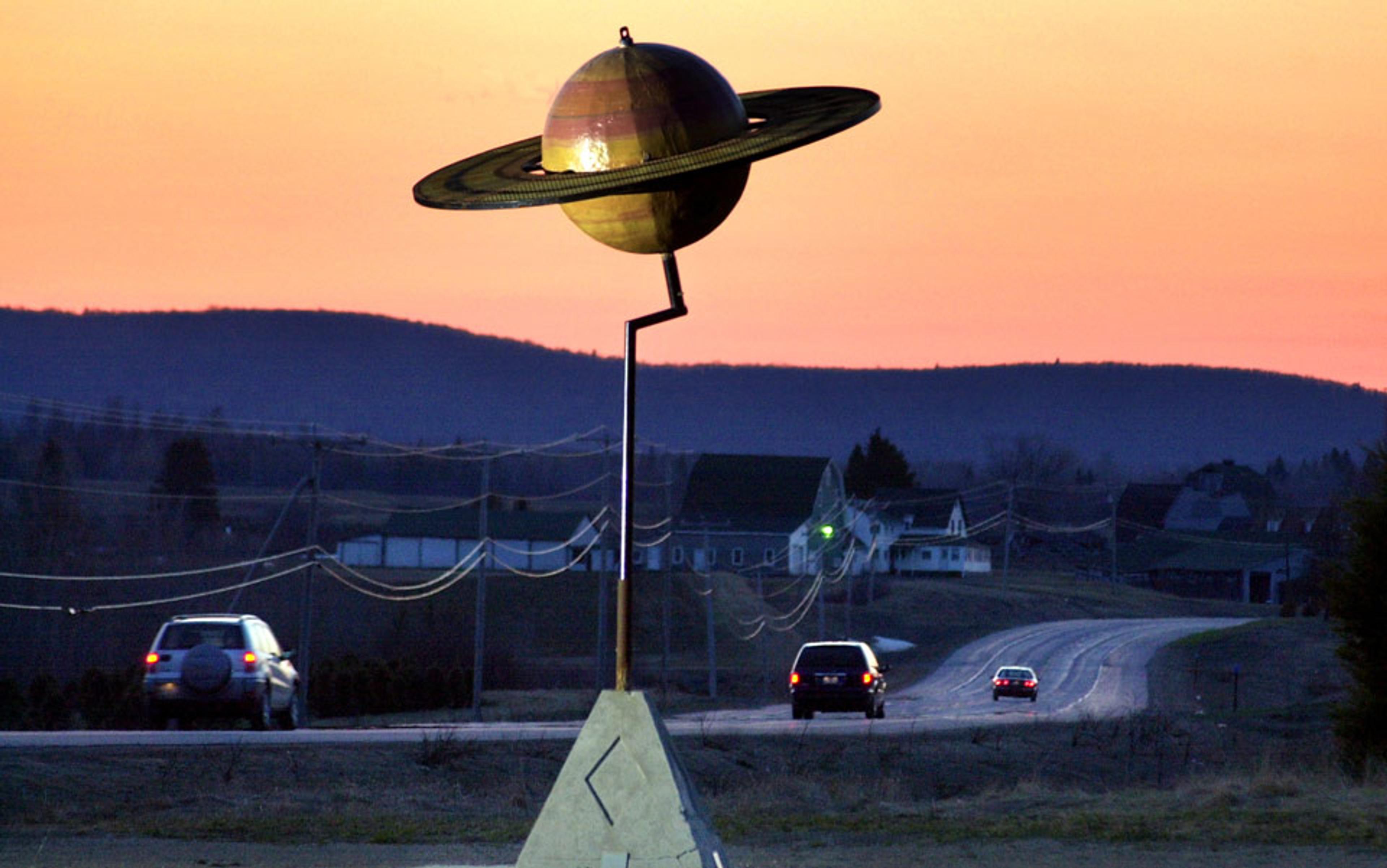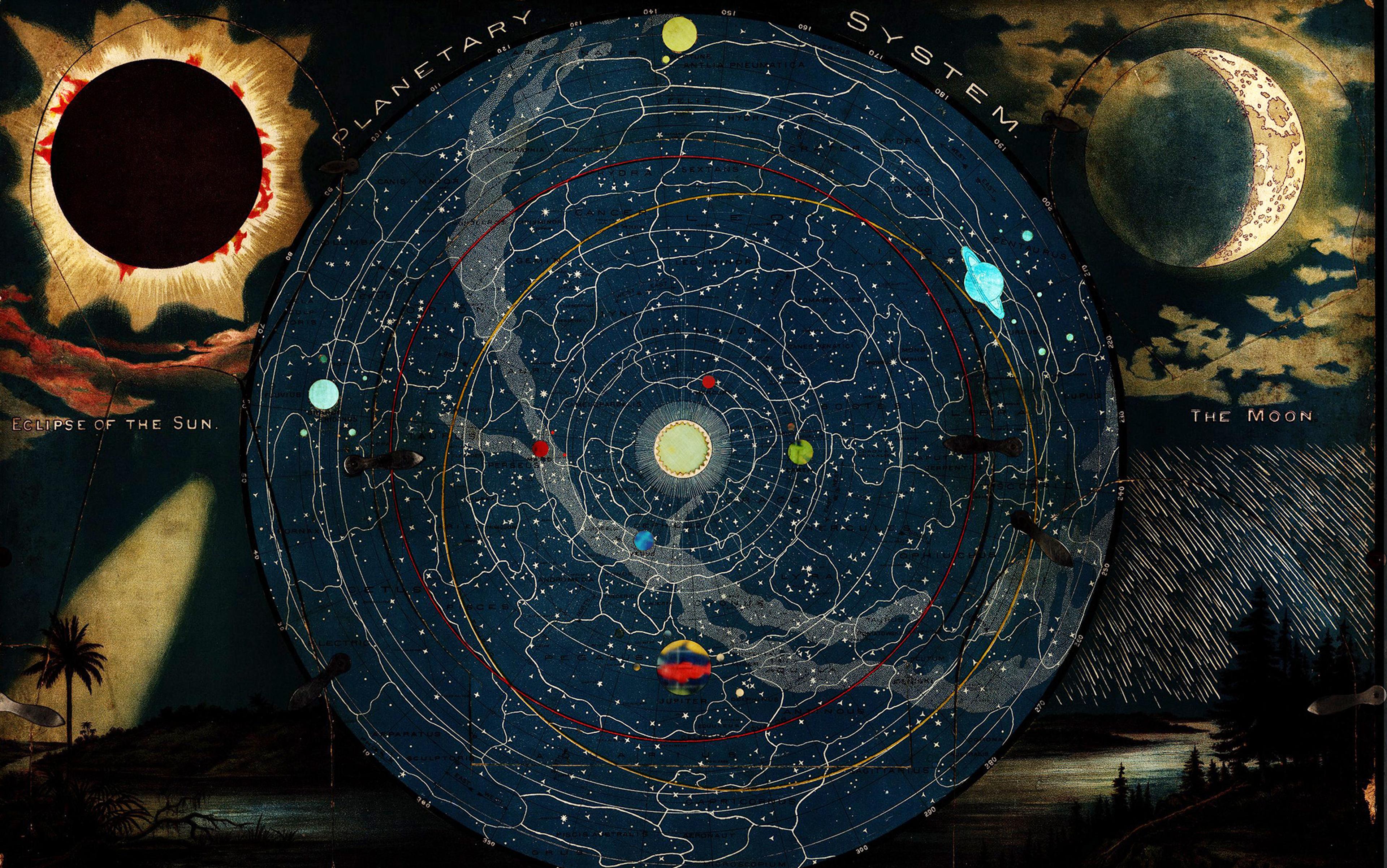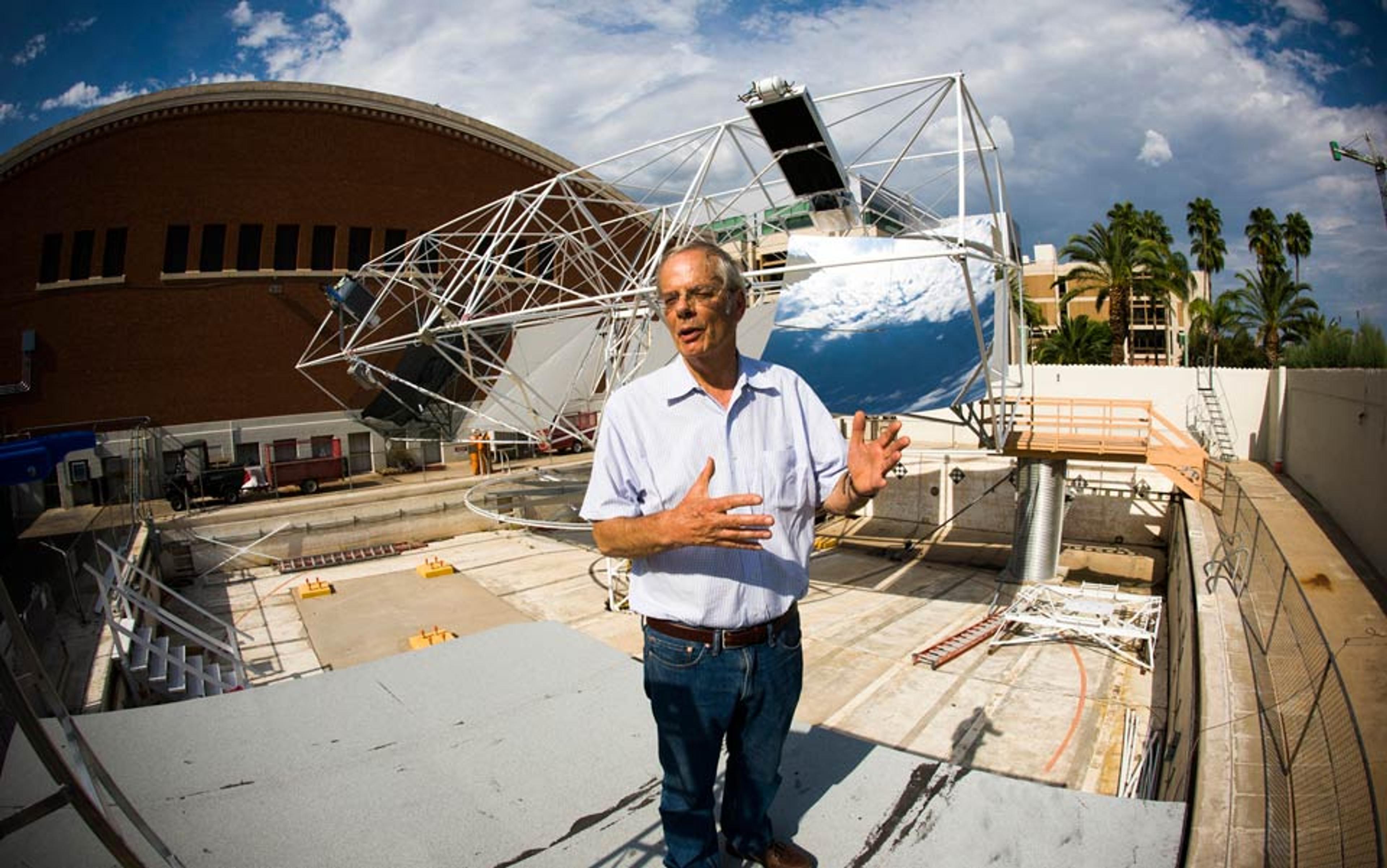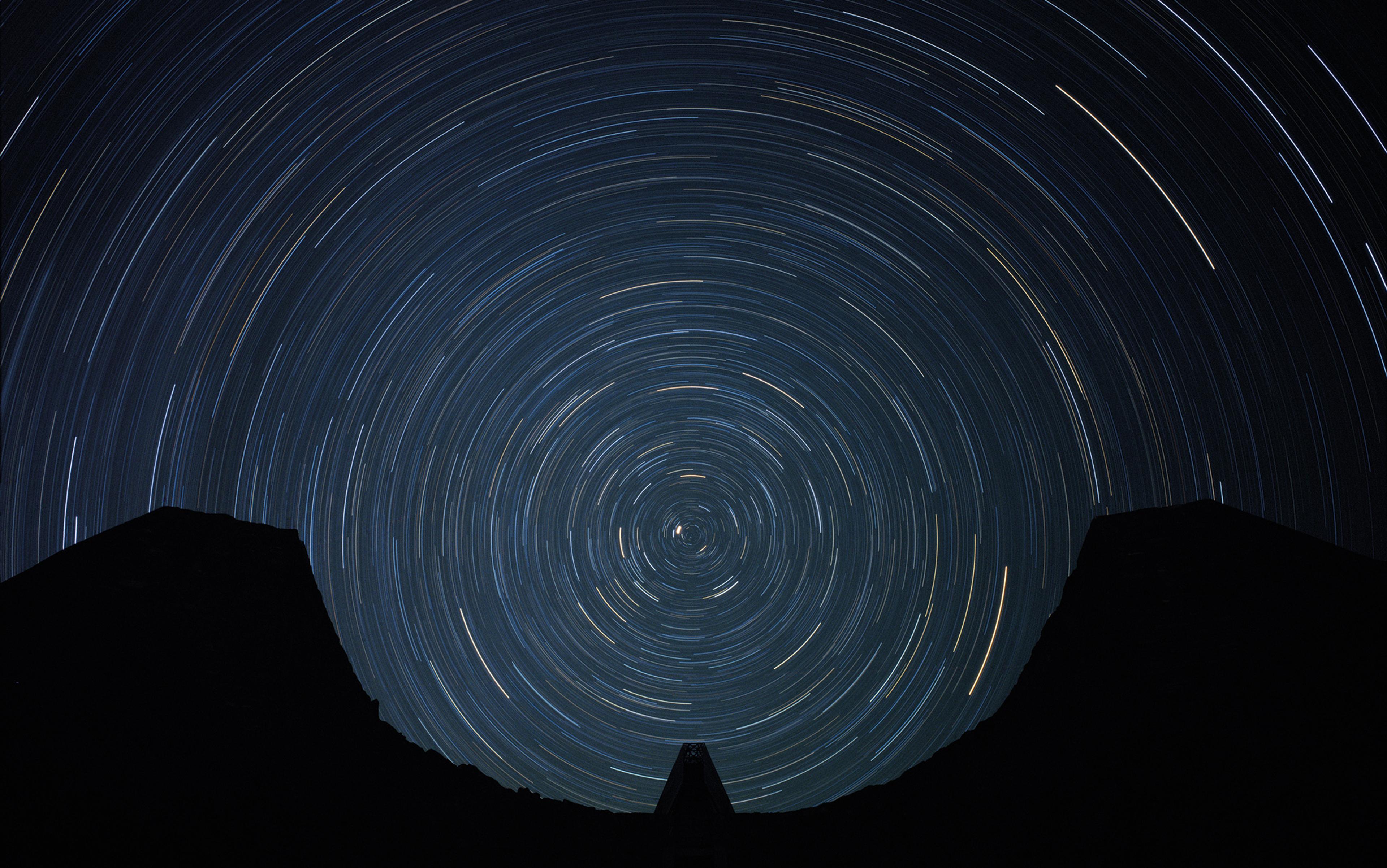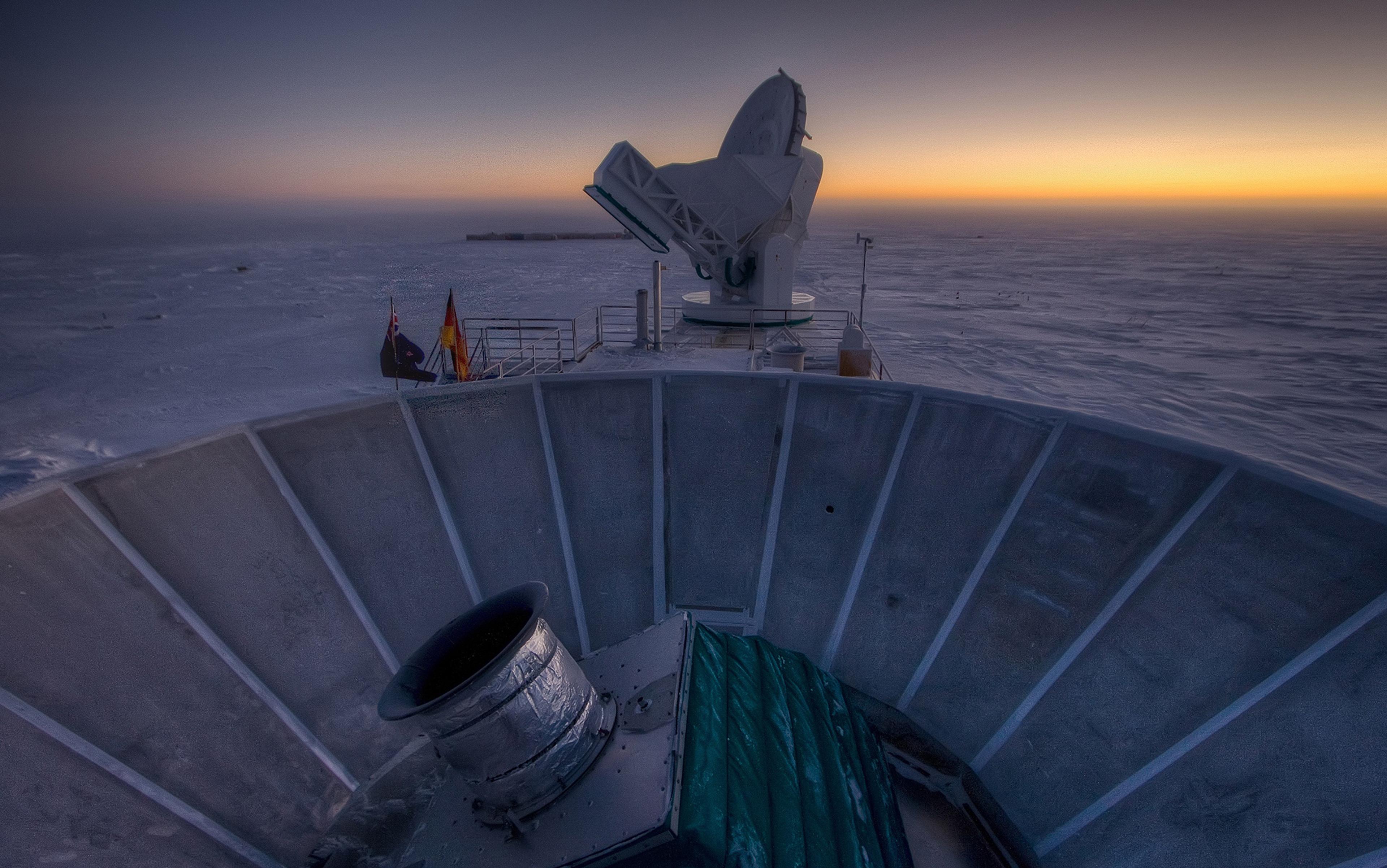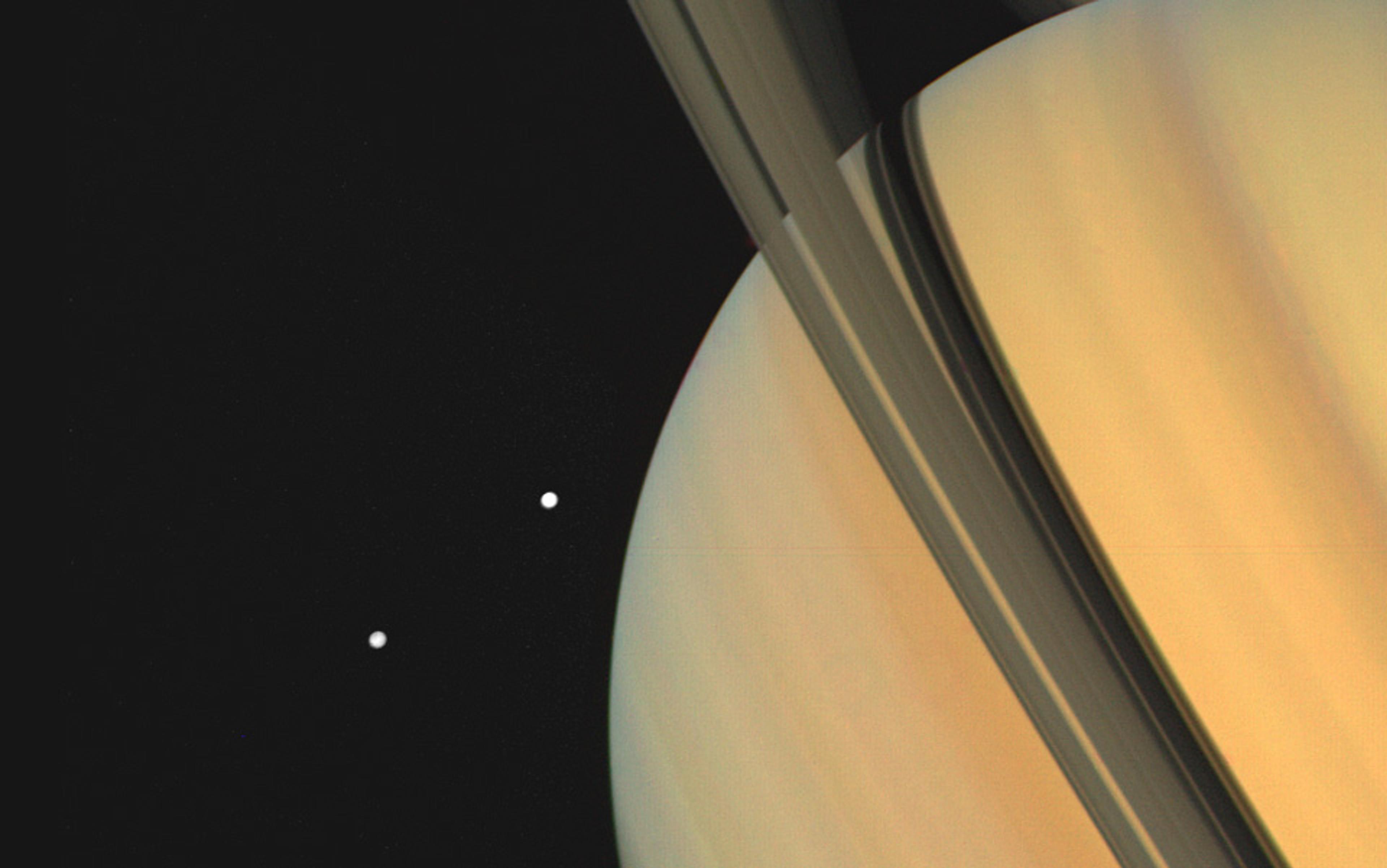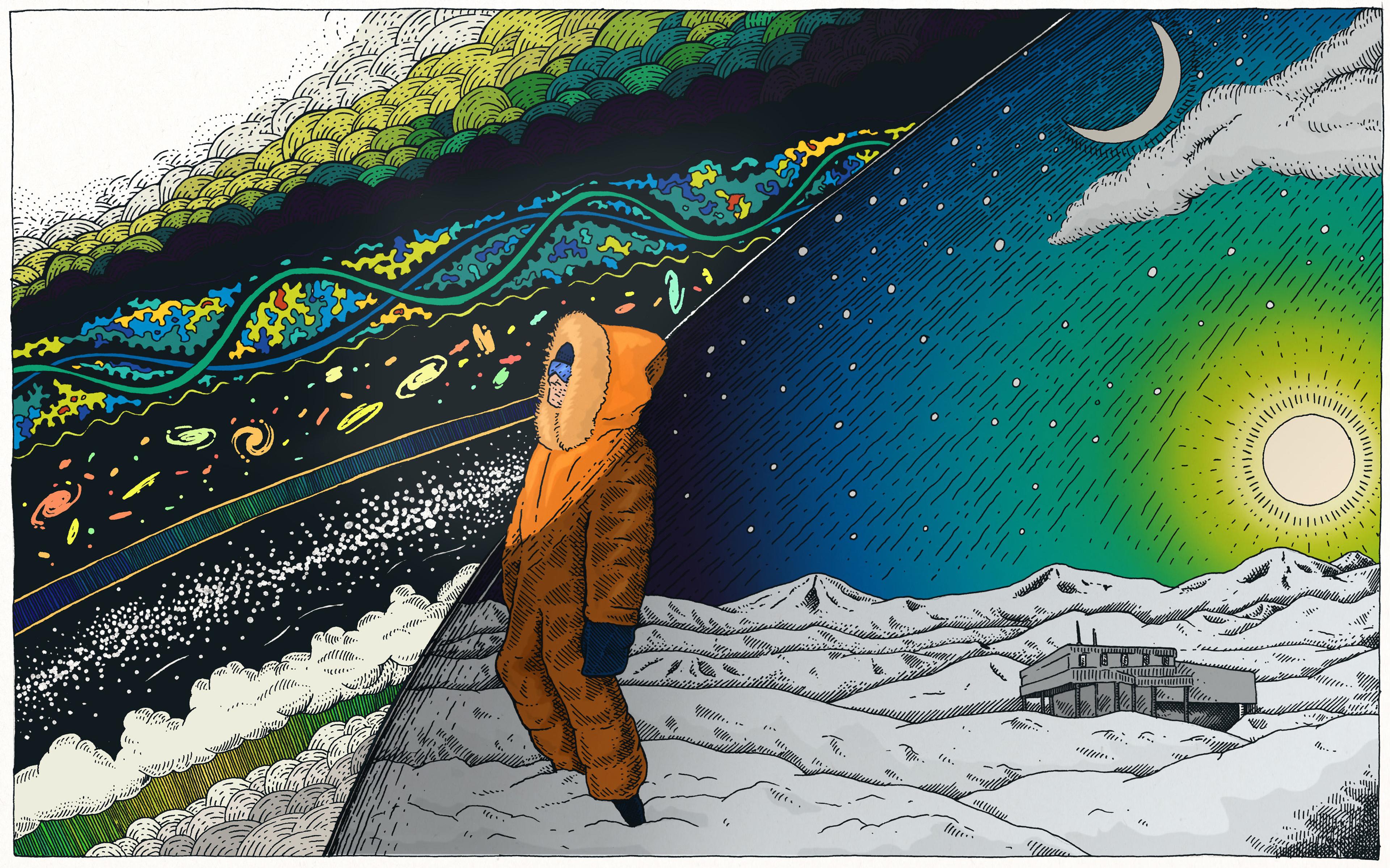A few Septembers back, on a Saturday afternoon, I took a long drive, from a leafy neighbourhood in Boston, Massachusetts, to the remotest parts of the outer solar system. I set out from Cambridge in a dusty, rented Volkswagen, with my co-pilot Andrew Youdin, a planet-formation theorist from the University of Colorado at Boulder. We drove north to Maine, aiming for Aroostook County, where, stretched along close to 100 miles of small towns, big farms and empty highway, you’ll find the world’s largest three-dimensional scale model of the solar system.
The outer edge of this imaginary solar system begins in an easily overlooked wooden box, wedged between two restrooms inside a visitor information centre in Houlton, Aroostook’s county seat. The box contains two small, off-white ceramic orbs. One of them is about the size of a large jawbreaker candy, with ‘Pluto’ engraved on a brass plate beneath it. The other orb, pea-sized and eight inches away on the box’s opposite side, is Pluto’s largest moon, Charon. A brochure from a nearby stand explains that the display is part of the Maine Solar System Model, conceived in 2000 and completed in 2003. According to a map printed on the inside fold of the brochure, the Sun lies 40 miles north, in a small town called Presque Isle. A jawbreaker model of Eris, the far-flung dwarf planet that spurred Pluto’s planetary demotion in 2006, lies 55 miles south, in Topsfield. At the model’s scale, Alpha Centauri, the closest star to the Sun, would be located a bit more than 250,000 miles away, on the dimpled surface of the Moon.
To encounter a scale model of the Sun and its planets is to realise that the solar system most of us learn about as children — and continue to envision as adults — does not really exist. A typical classroom poster depicts the planets extending out from the Sun in a close-packed sequence, like stepping stones an astronaut could skip across on a journey to the stars. In comparison with the Sun, each planet is usually shown scaled up tens, hundreds, even thousands of times its actual size. The asteroid belt, if it’s shown at all, is a thick clump of jagged brown rocks — when, in fact, the real asteroid belt is so vacuous that if you ploughed through it in a rocket, you’d be lucky to come within sight of a rock, let alone collide with one.
Educators aren’t really to blame: the limitations of the printed page and of the human eye sabotage any textbook’s attempt to accurately depict the vast, haunting emptiness of interplanetary space and the comparatively diminutive sizes of even the largest planets. Shrink the Sun down to the smallest typographic component — like the dot at the end of this sentence — and even Jupiter becomes microscopic, invisible. To bring a model of the solar system into the macroscale requires thinking over the horizon.
Call me when you’re at Uranus and I’ll meet you at Saturn, McCartney said
This planet-picturing problem was preoccupying Kevin McCartney one summer’s day in 1999 as he left a business meeting at the Houlton Visitor Information Centre and walked through the parking lot to his car to return to his office at the University of Maine at Presque Isle, where he is professor of geology and de facto head of community outreach. McCartney curates the university’s small science museum, located near his office in Folsom Hall. He had recently tried to revitalise the museum with a host of new exhibits, including a scale-model solar system exhibit stretching down a corridor in 1:150 billion scale, one metre per astronomical unit. Visitors loved it, and McCartney mused from time to time about making a proper three-dimensional model, where the Sun and its planets wouldn’t be paltry signs but fully fledged objects, enduring artefacts to be walked around and appreciated for generations.
McCartney had once heard of another scale model along a highway in Washington State, where a simple sign marked each planet’s location. On a whim, he set his odometer in the Houlton information centre parking lot, where US Route 1 splits off from I-95, and watched as the miles ticked up during the half-hour drive to his office. In the parking lot of Folsom Hall, the odometer read ‘40’. McCartney went into his office, pulled an old general science textbook from his musty, overstuffed bookshelves, and without sitting down, looked up Pluto’s average distance from the Sun: 40 astronomical units, one for every mile between Houlton and Presque Isle. Handy coincidence, that. He took a deep breath, and consulted the book for a moment more, running the numbers. There are about 93 million miles in an astronomical unit, so a scale model on Route 1 would be 93 million times smaller than the actual solar system. At that scale, the Sun’s sphere would be 50ft in diameter — too big to build in the round, too big to be shoehorned anywhere other than Folsom Hall where McCartney had the greatest oversight and authority. It could probably be represented by a painted archway in the building’s lobby and stairwell. Pluto would be placed somewhere around Houlton. At just under 5ft wide, Jupiter would be the largest construct. He gazed up at the particleboard ceiling and let out a long, low whistle. It could be done.
Soon after, he took his idea to James Brown, the director of planning and development for Presque Isle. The pair drove up Route 1 in Brown’s truck, McCartney cradling a chart of planet distances and an area map on his knees, marking Xs at proper locations. In the town of Littleton, there was a barren field where Neptune needed to be. The location of Uranus was in the vicinity of Bridgewater’s town hall. Monticello, the town between Littleton and Bridgewater, was passed over through unlucky orbital spacing. Saturn and Jupiter were both situated near potato fields outside of a town confusingly named Mars Hill. The orbit of Mars coincided with the town border of Presque Isle, and Earth, Venus, and Mercury all fell within its downtown. Each planet’s location coincided with businesses that Brown thought he could bring on board. The rest was just a matter of logistics and hard work. The inner planets and Pluto were put in place by the end of 2000. Jupiter was added in 2001, followed by Saturn in 2002. Uranus and Neptune completed the model in 2003, with a formal unveiling ceremony at Saturn on a sunny June day in 2003.
Standing next to Pluto, I called McCartney, reaching him at an office number I found listed on his academic website. After I introduced myself and explained that Youdin and I would like to meet him, McCartney half-jokingly asked if Pluto was still there. Its box is mounted at eye level, and the building is open to all comers, all day. McCartney said he had a half dozen ceramic dwarf planet replacements squirrelled away in a desk drawer for when the planet goes missing. I assured him that Pluto was in place.
Finding Pluto soaring eccentrically above the ecliptic was rather like finding a frozen mastodon gliding through the stratosphere
‘Great. Call me when you’re at Uranus and I’ll meet you at Saturn,’ McCartney said, before hanging up abruptly. As we left the information centre, we passed by a small table stacked with brochures, one of which was unmistakably celestial. It read: ‘NEW HORIZONS along the Maine Solar System Model,’ and depicted an object wending its way along the yellow centre line of an S-curving highway that stretched past the solar system’s outer planets and toward a distant star. The object was a NASA spacecraft, a planetary probe that had launched from Cape Canaveral in Florida in January 2006 on a one-way trip to Pluto. The probe is scheduled to fly by the dwarf planet in July 2015 to study its frigid surface, tenuous atmosphere, and fragile system of moons.
Shortly after it launched, NASA selected the Maine Solar System Model for inclusion in an associated outreach programme. Around the same time, a vote by the International Astronomical Union (IAU) demoted Pluto to ‘dwarf planet’ status, largely due to the recent discovery of the Pluto-sized planet Eris and other large objects in a region called the Kuiper Belt, at the outskirts of the solar system. Faced with a solar system of only eight planets, or one with potentially hundreds, thanks to all those large Kuiper Belt objects, the IAU chose parsimony over profligacy. The move ignited a firestorm of public criticism and a flurry of news stories mocking pesky astronomers for ruining primary-school curricula. McCartney and company took the demotion in their stride by updating the model with Eris and another reclassified dwarf planet, the large asteroid Ceres. They also built a second Pluto some seven miles north of the first, at the orbital location where the dwarf planet would be when the probe zings by it in 2015. After snapping a few shots of the demoted former planet, the probe will keep travelling outward, and eventually escape our solar system entirely, to drift in the darkness between the stars. If you extend its trajectory upon the Maine Solar System Model, you find that, fittingly, just as the spacecraft reaches the threshold of interstellar space, it enters the depths of the Atlantic Ocean, where the continental shelf gives way to rolling abyssal plain.
As we headed for Neptune, Youdin explained that, like all Kuiper Belt objects (KBOs), Pluto is easily distinguishable from the inner eight planets. A schematic illustration of the solar system would reveal that the eight major planets all reside in nearly the same orbital plane, called the ecliptic, which aligns with the Sun’s equator; they also all orbit the Sun in nearly circular, low-eccentricity ellipses. Against this celestial harmony, Pluto stands out like a sour note. For one, its orbit traces a high-eccentricity squashed oval rather than a near-circle, which causes it to spend a good fraction of each trip around the Sun closer in than Neptune. Pluto’s orbit is also inclined to the ecliptic by about 17 degrees. To capture the dwarf planet at the apex of its ascent above the ecliptic, the Maine model would need to place Pluto approximately eight miles above Route 1.
It’s strange to see such a wild outlier among the outer planets, for the far reaches of the solar system tend to be rather tranquil. There is so much wide-open space out there that even next-door neighbours are quite far away. Orbital interactions, to the extent that they do occur, transpire on timescales of hundreds, thousands, even millions of years. Because there are no giant planets in the deep solar system, we would have expected objects there to form in placid, nearly circular orbits closely aligned with the ecliptic, and remain that way. Like mammoths that fell and perished in icy crevasses during the Pleistocene, KBOs are ancient history physically preserved in cold storage. They are pristine, deep-frozen records of events that occurred long ago. Finding Pluto soaring eccentrically above the ecliptic was rather like finding a frozen mastodon gliding through the stratosphere: something very big must have thrown it up there.
Stare long enough at the jumbled bird’s nest of known KBO orbits, and curious patterns begin to emerge. Pluto is just the largest, most famous member of a large KBO swarm of what are called Plutinos that are locked in an orbital resonance with Neptune, completing two orbits of the Sun for every three that the ice giant makes. In celestial mechanics, an orbital resonance takes place when two orbiting bodies cyclically exert gravitational influences upon each other. Objects in this particular resonance siphon angular momentum from Neptune on one pass around the Sun, and give it back on their second orbit, forming a gravitational interaction that is stable on timescales of billions of years.
There was a short encore performance of planet-building about a half-billion years after the main event’s conclusion
A full quarter of known KBOs fall in this category. Unlike Plutinos, objects slightly further out mostly follow flattened, nearly circular orbits within the plane of the ecliptic — orbits that, just as we’d expect, seem scarcely changed since their origin in the primordial disk. For obscure reasons, objects in this population are unfortunately called Cubewanos. A final group completes the bulk census of the Kuiper Belt: scattered disk objects, or SDOs, are objects with very high eccentricities that take them more than twice as far as Pluto from the Sun. SDOs also have very high inclinations, so high that some of them orbit at 45-degree angles, relative to the ecliptic. Eris, Pluto’s same-sized cousin, is an SDO.
Strange as it sounds, the prevailing modern explanation for this diverse architecture is that the giant planets did not form where they now reside, but actually formed much closer to the Sun, where they all huddled together in a region of space that stretches between the current locations of Jupiter and Saturn. The distribution of KBO orbits suggests that a few hundred million years after their formation, the outer giant planets, Uranus and Neptune, pulled up their stakes from this close-packed configuration and moved, migrating outward to new orbits, running roughshod through a thick disk of planetesimals — kilometre-scale balls of ice and rock leftover from the solar system’s formation — stirring and scattering them into the populations we see today.
The planetesimals at the thin outermost edge of the disk barely felt the gravitational effects of Uranus and Neptune, and thus became the placid Cubewanos. Planetesimals in the inner portion of the disk were captured in stable orbital resonances by Neptune to become Plutinos and a handful of other resonant objects. One of them, a Pluto-sized ball of ice we call Triton, even came close enough to Neptune to be captured as its largest moon. Most of the inner-disk planetesimals, however, were flung into high eccentricities and inclinations to become SDOs, albeit only temporarily, for their eccentric orbits are unstable. Eventually, they will swing within range of Neptune, where they’ll begin a long process of redistribution into the other parts of the solar system.
Many of these disrupted SDOs get zipped into a gravitational daisy chain that operates between the giant planets. An SDO might orbit inward of Neptune for a million years, but eventually a close encounter with Uranus will toss it closer to the Sun, into the intermediate zone between Uranus and Saturn. A few million years more, and a close call with Saturn will pass the SDO into the intermediate zone between the ringed planet and Jupiter. At certain points in this interplanetary game of hot potato, there is a slight chance that an SDO will collide with a giant planet or be captured into stability, as a moon or member of the asteroid belt, but most reach Jupiter unstable and unscathed. We can confidently say all this because this redistribution is still happening today. Indeed, astronomers have found SDOs on unstable orbits in each successive intermediate zone between the giant planets. They call these infallen SDOs Centaurs, after the mythical hybrid of man and horse, because they resemble comets in composition but asteroids in their orbits.
A small plaque at the planet’s base read: ‘June 15, 2002: This site dedicated to Alvin F Reeves the Second, potato breeder, community leader’
At Jupiter, the final stage of the scattered disk’s redistribution occurs. Being far more massive than the other giant planets, Jupiter can put a serious swing into a Centaur’s orbit, easily boosting it into trajectories that can take it to the edge of the solar system and beyond. NASA’s Pluto probe took advantage of this effect when it flew by Jupiter in 2007, increasing its outbound speed by 2.5 miles per second, more than enough to hit heliocentric escape velocity. Most of the Centaur outcasts settle into orbits with periods of many thousands, even millions, of years. They form a vast, loose shell of icy debris that extends outward further than a light year from the Sun. This structure is called the Oort Cloud, after the Dutch astronomer Jan Oort, who predicted its existence in 1950. When tickled by nearby stars or galactic tides, the Oort Cloud will sprinkle a few objects back down into the solar system to become long-period comets. Some of these, by passing chance, could conceivably be perturbed back into the scattered disk on their way down, becoming recycled SDOs that can traverse the gravitational daisy chain anew.
The Centaurs that Jupiter doesn’t cast out of the solar system are sent inward instead, where they manifest as short-period comets, eventually evaporating near the Sun or colliding with one of the inner planets. It was by this circuitous route that water and fertile organic compounds fell upon the Earth, helping life to originate and flourish. As Neptune made its way outward, disrupting the planetesimal disk, it stirred up a flurry of comets, turning the inner solar system into a shooting gallery, a confusion of icy crossfire.
Versions of this story have been floating around for a long time, and data to support it continues to accrete. In 1694, Edmond Halley made a presentation to the Royal Society suggesting that a comet struck the Earth and caused Noah’s Flood, though not through delivered water, but rather through the slosh of huge land-drowning waves thrown up by the shock waves following the impact. The more modern version can be traced to a 1975 hypothesis from the theorist George Wetherill, who postulated that Uranus and Neptune formed hundreds of millions of years later than the other planets in a burst of activity that showered the inner system with comets.
The current version of the story is supported by indisputable evidence, taken from the remnants of Earth’s oldest rocks — resilient silicate crystals 4.38 billion years old, that show signs of impact shock-heating approximately 3.9 billion years ago. Radiometric dates for rock samples returned by Apollo astronauts from the Sea of Tranquility, the Ocean of Storms, and other lunar impact basins all cluster around the same time, as do the ages of impact-generated meteorites thought to originate from Mars, the Moon, and the asteroid Vesta. All of this evidence suggest there was a short encore performance of planet-building about a half-billion years after the main event’s conclusion. Astronomers have given this turbulent, ice-circulating epoch a name: the Late Heavy Bombardment.
Despite a long, eye-straining search, Youdin and I never found McCartney’s second Pluto, the one positioned to represent the 2015 rendezvous with NASA. But after passing the aptly named Stardust Motel in Littleton, and doing a double-take at an oversized cobalt-coloured ‘gazing globe’ lawn ornament, we did find the real Neptune, sitting atop a tall steel pole like a blue basketball. The planet looked like it had seen better days — what first appeared to be cotton-puff clouds on closer inspection proved to be white primer peeking out in patches where paint had flaked away. Uranus and Neptune are commonly grouped with the gas giants, Jupiter and Saturn, but they are in fact a different class of planet entirely. Unlike Jupiter and Saturn, which have enormous envelopes of hydrogen and helium, Uranus and Neptune have far less gas and higher proportions of ice. They are diminutive ‘ice giants’, possessing roughly a sixth of Saturn’s mass and a 20th of Jupiter’s.
Around 10 miles up the road, past Monticello and just outside of downtown Bridgewater, we passed by Uranus, which was painted robin’s-egg blue and tilted over on its side like a fallen spintop. Lacking a system of large moons and devoid of obvious cloud bands or storms, Uranus is a relatively bland planet that even astronomers sometimes struggle to love. But its odd tumbled-over axis of rotation is compelling to advocates of the Late Heavy Bombardment. ‘Here we have more evidence before us, evidence for major late-stage impacts,’ Youdin said as we rolled by. ‘Back before the solar system settled down, there really were big things that went bump in the night. Something as big as Earth could have walloped Uranus at some point, and set it rolling on its side.’ As Youdin circled the leaning ice giant, I pulled out my mobile phone, dialled McCartney, and told him we would soon be at Saturn.
That Uranus and Neptune were born closer to the Sun is considered gospel by most theorists today, and not only because migrating ice giants provide a mechanism for populating the Kuiper Belt and delivering water to the inner solar system. The more important motivation is that Uranus and Neptune are simply too large to have formed in their current locations according to how theorists believe world-building unfolds, via the stepwise collision and accretion of planetesimals that eventually reach ever-larger solid assemblages. Youdin explained that, on the prevailing theory, protoplanets hundreds of miles wide come first, then Moon-to-Mars-sized planetary embryos, and finally full-grown planetary cores up to 10 times the mass of Earth. In the gas-impoverished inner system, the cores were the finish line, and became the terrestrial planets. In the gas-rich outer solar system, the cores swept up thick atmospheres to become the giant planets. Gas and planetesimals were both plentiful where Neptune and Uranus are now, but the material moved so slowly, and was spread out over such vast amounts of space, that assembling ice giants would have taken longer than the current age of the solar system.
Night after night, when he returned home from a long day of teaching classes, the sweet smell of apple pies — baked bribes for volunteers — would drift out to the sidewalks and streets surrounding McCartney’s home
Glimmers of recognition that planets could radically and rapidly change their orbits within a disk first emerged in the late 1970s and early ‘80s, but the idea of planet migration still remained somewhat heretical. Centuries of consensus held that worlds did not drastically move during and after their formation. Planets were thought to grow from a disk almost like trees from soil. Perhaps they swayed a bit under the gravitational influence of gusts of gas, or clouds of planetesimals, but they were otherwise thought to be more or less rooted in their orbits. All that changed in the 1990s with the discovery of hot jupiters, supermassive exoplanets that swung around their stars in orbits closer than Mercury’s. There was simply no way such large planets could form so close to a star; migration was the only answer.
‘You’ve got to wonder how alive and well the Copernican Principle really is,’ Youdin mused as we departed Uranus for our Saturnian rendezvous with McCartney. ‘It seemed to be growing stronger over the past few centuries as we found many stars, many galaxies, and now many planets. Knowing that’s all out there makes us seem quite typical, but the details of these extrasolar planetary systems have made things much less clear. So many of the exoplanets we’ve found have high eccentricities. A high eccentricity is a scar from a violent past. If planets in our solar system interacted and migrated as much as theory suggests they had to, you wonder how exactly they managed to get back to these near-circular orbits.’
Some 10 miles past Uranus and north of the town of Mars Hill, Youdin and I crested a hill and saw Saturn below, ringed and resplendent on a thick metal pole above a pyramidal concrete base, surrounded by a small gravel parking lot. We parked and got out to stretch our legs while we waited for McCartney. A small plaque at the planet’s base read: ‘June 15, 2002: This site dedicated to Alvin F Reeves the Second, potato breeder, community leader.’ Youdin gazed up in admiration at the canted disk of steel grillwork that represented Saturn’s rings. ‘This is really quite a piece of work — the scale of the rings is a bit off, but they got the axial tilt right,’ he said. ‘The rings would coalesce into a moon if they didn’t reside in Saturn’s tidal disruption radius. They’re made from rock and ice, not gas, so you can see some really clean, exquisite structures — gaps opened by moonlets, resonant patterns of density waves spiralling through the different zones. Maybe a moon’s orbit decayed, and Saturn tore it apart into rings. Or the rings might have been here since Saturn’s formation. But in that case you can’t just lay them down four billion years ago and expect them to persist until today. Maybe they replenish their material from infalling moonlets and little comets.’ I picked up a pebble and arced it overhead, where it clattered and lodged in the steel disk, adding another moonlet to the planet’s ring system.
Behind us, the crunch of tires on gravel announced McCartney’s arrival. We turned to see a mid-size blue hatchback pulling into a parking space. The license plate read ‘OLD IRON’, and a Jesus fish sprouting Darwinian legs adorned the bumper. McCartney wore a wiry Lincoln beard mostly faded to salt from pepper, and wore a khaki newsboy cap, spectacles, and a light jacket. He leapt from the car with an energy belying his 59 years and strode forward to gregariously pump our hands in a delicate grip. McCartney has a local reputation as a brash yet gentle man.
‘I’m still amazed all this actually exists. Again, there was no money, no money at all. There were 12 schools involved in all. I have a list of the schools, the classes, the students, and other folks who helped. There are more than 700 names on the list. One of my original goals for the project was to have more than one per cent of the total population of northern Maine involved. You look at the census, and northern Maine’s got about 70,000 people. More than 700 of them worked on this, so we got past that one per cent.”
In some ways, building McCartney’s solar system might have been more difficult than gravity’s inexorable assembly of the real thing. In his quest for volunteers, he seems to have cajoled his way across the geographic and socioeconomic width and breadth of northern Maine. He had enlisted a small army of civil servants and upstanding business owners to vouch for him to the Maine Department of Transportation, which eventually approved construction. A civil engineer tweaked the blueprints for the proposed structures until they could, at least on paper, withstand a ‘storm of the century’ and persist maintenance-free for 50 years. High-school students in the steelworking programme at the Caribou Technology Centre forged the metallic cores of Saturn and Jupiter, welding steel plates together in pie sections to form a skeletal sphere. The body-shop programme fit slices of foam into the pie sections, sanded them down until they were spherical, and encased them in fibreglass. Lowboy tractor trailers from the high school’s heavy-equipment programme ferried the assembled planets to multiple locations around Aroostook County for storage, painting, and eventual on-site set-up.
McCartney slapped the concrete base of Saturn with satisfaction and told us the entire assemblage weighed approximately two tons. The bases were poured at the former Loring Air Force Base in nearby Limestone by members of the local Job Corps. Installing Jupiter and Saturn required a crane, heavy trucks, and a police escort along Route 1 to safeguard the wide load. Members of a local Kiwanis volunteering club built Saturn’s parking lot and small garden. Teams of students from southern Aroostook vocational schools made most of the posts for the planets and moons, except for Saturn’s, which was constructed by a professional welder. Regional Rotary Clubs made small donations for the project’s meagre incidental expenses. Scout troops, 4-H youth development clubs, and a local Future Farmers of America chapter planted flowers in beds of cedar mulch around many of the models. Even when the project had taken on a life of its own and moved forward through momentum alone, McCartney’s work wasn’t done. Night after night, when he returned home from a long day of teaching classes, the sweet smell of apple pies — baked bribes for volunteers — would drift out to the sidewalks and streets surrounding McCartney’s home.
We returned to our cars for the five-mile drive north to Jupiter, past fields of potatoes and a ‘Moose Crossing’ sign
The planets have become a daily part of life for residents of Aroostook. They serve as convenient landmarks — a house in downtown Presque Isle is said to be ‘two miles past Jupiter’, and Saturn is a common rallying point for road-tripping caravans. Locals call McCartney when they see something amiss. Someone once snipped Eris off its pole in Topsfield, and Saturn’s rings sometimes accumulate structure-straining drifts of snow that are best knocked off. They have grown accustomed to slow-moving cars filled with rubbernecking out-of-towners, though no one is certain exactly how much tourism the model has brought in.
Daylight was fading, so we returned to our cars for the five-mile drive north to Jupiter, past fields of potatoes and a ‘Moose Crossing’ sign. McCartney talked fast, but he drove faster, leaving us scrambling to fasten our seat belts and start the engine just in time to see his taillights vanishing over a hill in the distance. When we arrived, we saw Jupiter, 5ft in girth, peeking out from behind a pulled-over long-haul big rig that was using the parking lot as an informal rest stop.
Following McCartney into the centre of town, we traversed the entire inner solar system in less than five minutes, with whole worlds passing by in a twilight blur, too closely packed for any meaningful reflection, ephemeral against the outer solar system’s spacious majesty. We found Ceres, the largest asteroid, serendipitously amid an asteroid belt of sorts — a gravel driveway in a construction zone for a new Jehovah’s Witnesses church. It had the dimensions of a small marble.
Just a half-mile north, Mars was a hard rubber baseball sheathed in fibreglass, sitting next to a ‘Welcome to Presque Isle’ sign. A few blocks further, and we found Earth, the size of a large orange, in the parking lot of Percy’s Auto Sales, its golf-ball Moon placed just 16ft away, a concrete reminder of how short a distance we humans have flown from our home. Three more blocks and we passed Venus, a bland white orb outside the Budget Traveller Motor Inn. It occurred to me that, in a scale model that spanned nearly 100 miles from inmost Sun to outmost Eris, these six short blocks represented the entirety of the solar system’s standard habitable zone, where liquid water could potentially exist within a rocky planet’s atmospheric shroud.
Tiny Mercury lurked just up the road in the front garden of Burrelle’s Information Services, and gave the greatest surprise of the whole trip. Before the discovery of hot jupiters, Youdin explained, no one really understood just how much empty space lies between our inmost planet and our star. Everyone imagines Mercury hellishly close in, scraping its rock-and-iron face against the solar photosphere, but the scale-model Mercury sits more than three football fields from the Sun. With so many exoplanetary systems sporting packed-in planets, astronomers are baffled as to why the first 30 million miles out from our star are so barren.
Inside Folsom Hall, McCartney showed us the Sun, a 50ft yellow-painted archway, and the modest collections of the Northern Maine Museum of Science. A number of empty glass cases suggested that the museum was in decline. McCartney said he was working on grant proposals to revamp several displays. He had been the driving force behind the museum well before its opening in 1996, and had begun planning its creation not long after his arrival at the university in 1988.
Nowadays, a third-grader comes through here, and maybe they don’t learn a whole lot, but they find out that science is neat
‘People tell me that if I die, the museum is toast,’ he said, ferrying us past his hallway-scale solar system and cases containing the jawbone of a whale and an embalmed sea turtle. In his office, McCartney said he was trying to find time to prepare for a trip to a scientific conference in Poland. He’d been invited, he told us, because his research had recently ‘gone viral’. He pulled what looked like a black-and-white photograph of a pinwheel from somewhere in the stacks of papers and books that threatened to overflow his desk. The pinwheel was a silicoflagellate, a relatively obscure group of marine single-celled plankton. Their microscopic skeletons constitute approximately one per cent of the silica found in sediments on the deep sea floor, and are used to date core samples and constrain oceanic environmental conditions over the past 100 million years.
McCartney is one of the world’s foremost experts in their morphological classification and distribution. On a research sabbatical in 2009, he found and described two new genera and 18 new species. ‘I’ve been trying to find the environmental reasons for certain shapes,’ he told us. ‘There’s a lot to figure out, and I doubt we’ll get it all done in my lifetime. This is just my little brick for the cathedral of science.’
I wondered aloud why he spent so much of his time on side projects like the museum and the model instead of devoting more of it to his research. The corners of McCartney’s mouth turned down for a moment, then he said: ‘I never had anyone teach me about science when I was a kid, and my parents weren’t very encouraging. I remember my first day of school in fourth grade. We had to talk about what we’d done for the summer. One guy came up and said he’d gotten a microscope and had been using it. I raised my hand and asked what a microscope was. I had no idea. Of course the whole class erupted in laughter at this silly, stupid kid who came out of nowhere not knowing anything. So I got in the science section of the school library and read a book. By the end of the year I’d read them all, shelf by shelf.
‘My interest caught fire, but I’m convinced that was only because there was already gunpowder on the ground. What laid out the gunpowder was a visit I made to a museum in second grade, the one at the Academy of Natural Sciences in Philadelphia. Nowadays, a third-grader comes through here, and maybe they don’t learn a whole lot, but they find out that science is neat. That’s the role of a science museum: to be there for that little kid, to give them this precious experience, and years later, who knows how long, that experience flowers. You won’t be there when the flowering happens, but you can be there when it begins.’
